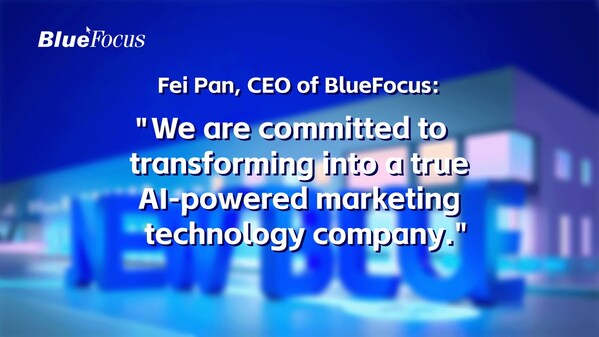
BEIJING, April 28, 2025 /PRNewswire/ — Recently, BlueFocus released its 2024 Annual Report, recording a total revenue of RMB 60.797 billion for the year, marking a 15.55% year-on-year increase and making it the first marketing company in China to surpass the RMB 60 billion milestone. Below is “A Letter to Our Investors” by BlueFocus CEO Fei Pan.
Dear Investors,
This year marks the 15th anniversary of BlueFocus’s public listing, and the forthcoming 30th anniversary of our founding. From our origins as a modest local company, we have steadily grown into one of the world’s top ten Marketing and Communications Groups—a transformation made possible by your enduring support, trust, and encouragement. On behalf of the entire BlueFocus Group, I extend my deepest gratitude. To our shareholders, clients, partners, and above all, the colleagues who have walked alongside us through every challenge and triumph, I say thank you. BlueFocus would not be what it is today without you.
China’s marketing industry has reached a scale of over RMB 1 trillion, and the global outbound market is of comparable size. Together, these two trillion-RMB arenas now stand at the cusp of a historic transformation, one that will be fundamentally reshaped by Artificial Intelligence (AI). At such a pivotal moment in time, conservatism and complacency are nothing short of perilous. I often ask myself: What is the underlying logic that sustains our long-term growth? What is the true value and meaning of our existence? And what does it mean to truly honor the legacy of tradition and the past? I believe the answer lies in one word: innovation, which is the drive to build a better, stronger, and more resilient BlueFocus.
What does a reimagined BlueFocus look like? It means transforming ourselves into a true AI-powered Marketing Technology Company, breaking away from the traditional logic and business models that have defined marketing since its inception. It means becoming a global company, rooted in China and built to thrive on the world stage. It means growing into an enterprise of RMB 100 billion scale, one that combines technological DNA with global imagination. This is not merely a vision, but a clear and deliberate pursuit. If we succeed, it will have profound meaning for our industry, our clients, our shareholders, and our colleagues. If we fail, it will still be a failure we can wear with pride. AI represents both the greatest opportunity and the greatest risk our generation has ever encountered. And as I have said before: AI is the defining core of BlueFocus. It will either dismantle us or redefine us into something entirely new. In the face of deep uncertainty, we must confront today’s challenges with the mindset of tomorrow, grounded in the perspective and logic of the AI era. We must think and act with the end in mind, and seize the new opportunities ahead. If we do, I believe that many of the questions and challenges we face will resolve themselves, and light will break through where the road once seemed unclear.
From here, I would like to share our current status and forward-looking thoughts by aligning the vision with operational realities. This reflection is centered around three key questions that address the concerns shared by many of you: How substantial is the value behind BlueFocus’s “All in AI” strategy? Amid growing geopolitical and trade tensions, how are we approaching and adapting our massive global outbound business? And finally, how healthy is BlueFocus’s overall operational performance, and what potential risks do we foresee?
First question: At a time when everyone is declaring they’re All in AI, what is the real value behind BlueFocus’s All in AI strategy? And more importantly, what does it truly mean to be All in AI?
Let me first return to the origin, to speak about intention, mindfulness, and long-termism. Today, AI has deeply integrated into more than 95% of BlueFocus’s operational scenarios, driving efficiency gains across integrated marketing, intelligent advertising, and our global outbound business, with improvements ranging from 60% to 1000%. These numbers look promising, and efficiency gains have indeed become the dominant narrative of today’s All in AI era. While AI’s role in lowering costs and boosting efficiency is substantial, for BlueFocus, they are not the metrics that define our strategic intent. If AI is to be our generation’s defining paradigm shift, then starting with cost reduction as our primary aim risks leading the company into strategic disorientation. Our goal is clear: to fundamentally restructure everything through an “AI Native” approach and logic, reimagining business scenarios, redefining and inventing new business models, reshaping the talent-to-business structure, and rebuilding our organizational structure and culture. Only by doing so can we move closer to, and be worthy of, our strategic ambition: to become a truly AI-powered Marketing Technology Company.
For BlueFocus at this stage, there are elements far more important than the raw numbers behind cost reduction and efficiency gains.
It starts with real, sustainable business scenarios. These are environments where AI capabilities are continuously iterated through practical application, and where both process and outcome data can be labeled and refined. Today, BlueFocus uses AI to generate nearly 80,000 pieces of content each week across data analysis, content creation (text, images, video, and multimodal formats), and code generation. Our AI tools currently support around 600 clients, and in the past year alone, we executed over 1,500 AI-driven cases. On the revenue side, AI-enabled revenue has grown more than tenfold, reaching RMB 1.2 billion. We expect to achieve RMB 3 to 5 billion in AI-driven revenue by 2025, and in just the first quarter of this year, that figure has already nearly matched our full-year total from last year. Looking ahead, my aspiration is for AI-driven or AI-powered revenue to surpass RMB 10 billion in the coming years. This RMB 10 billion in AI revenue will be defined by three benchmarks: high gross margins, high AI intensity, and the emergence of new revenue models made possible by AI. Ultimately, 70% to 80% of BlueFocus’s future revenue must be reshaped by AI, transformed into high-quality revenue. It is not the usage volume, the number of cases, or even revenue that matters most. What’s essential is the ability to iterate AI deeply within business scenarios, where data, workflows, and operational logic are continuously refined. This is the defining benchmark for whether BlueFocus can truly become an AI-driven company.
It requires a truly self-developed AI platform and model. BlueAI is fast becoming the new engine that powers AI-driven applications across BlueFocus. It is our proprietary AI platform, our own “multimodal AI model for marketing,” purpose-built to meet BlueFocus’s strategic needs. What has BlueAI achieved so far? First, we have established deep and comprehensive partnerships with the world’s leading large model and intelligent cloud providers, including ByteDance Volcano Engine, Baidu AI Cloud, Alibaba Cloud, Microsoft Azure, Google Cloud, and Amazon Web Services. Building on these foundations, we are developing our own industry-specific models tailored to marketing scenarios. Second, through real-world marketing applications and case-driven deployment, we have already labeled and trained over 120 million anonymized industry data points. Of these, 66.9% come from video-related data, 23.3% from advertising performance data, and 9.8% from social media text data. Third, BlueAI now supports more than half of BlueFocus’s project cases across both global and domestic marketing scenarios. Internally, we have incubated approximately 100 AI agents to scale and deepen our capabilities. Looking ahead, we aim to build on our growing base of content-scale data to power a self-reinforcing data flywheel, from factual data annotation, to content creation and delivery, to continuous deep learning. Our ambition is for BlueAI to become the most competitive model in the marketing industry and the next strategic engine of BlueFocus. When the time is right, we will also consider opening it to the broader industry, establishing it as a core infrastructure for the future AI marketing ecosystem.
It builds on true AI infrastructure and robust data systems. By the end of this year, BlueFocus is projected to label over 200 million data records across marketing scenarios, with API token usage approaching hundreds of billions in scale. Coupled with the growing pool of process, operational, and media performance data accumulated across our business middleware systems, we are laying the groundwork for “emergent intelligence” under the new AI paradigm. Our top priorities for 2025 include the development of AI Agents; the modularization and API enablement of core marketing automation tasks, such as generation, publishing, and analytics; the fine-tuning and retraining of domain-specific models; and continued investment in both data and technology for video-based AI models.
It takes deep organizational transformation and a bold talent strategy shift. At the organizational level, AI has become a hard-coded standard embedded in recruitment, promotion, and incentive structures. “No AI, No Bonus, No Promotion” is not just a slogan, but a decision-making principle that guides how we operate. We have appointed a Chief Growth Officer for AI and established AI Business Partner (AI BP) roles across all business units, each with real influence and decision-making authority. In parallel, AI awareness and performance indicators have been integrated into executive-level accountability frameworks. This is the key to breaking through structural ceilings, because in the journey to go All in AI, the greatest obstacle is not technical, but cognitive. Looking ahead, I expect 30% to 50% of our management team to be AI-proficient or AI Native. These leaders, together with AI seed talent and product and technology professionals, will become some of the highest-earning individuals in the company and in the industry, entrusted with the mandate to “steer” core business decisions. Those who master AI will be promoted through accelerated, unconventional pathways. Those who do not will be gradually sidelined, as we fully commit to an “AI First” model. Today, BlueFocus already has nearly 300 product and technology professionals and 200 AI Native seed talents. They are our strategic safeguard in becoming AI Native, and the foundation of our innovation. We are embedding technical DNA, internet-native thinking, and first-principles logic into the heart of our organization. The ultimate organizational form of BlueFocus is a hybrid: “a high-tech company and a marketing company, integrated into a singular, future-ready organization.”
With real scenarios, datasets, technology platforms, and a fundamental shift in organizational paradigms, we are methodically constructing durable vertical moats, barriers that differentiate us not only from general-purpose foundation models but also from competitors within our own industry. And of course, one thing matters most of all—resolve. In 2025, our support for AI innovation remains unconditional. Beyond continuing the foundational pillars outlined above, we are also pursuing several difficult but essential breakthroughs: First, a breakthrough in AI Agents. BlueFocus currently operates around 100 AI Agents. Our goal is for at least 20 of them to reach expert-level performance, evolving from Account Executive (AE) capabilities to advanced specialist roles, and ushering in a new era of human-AI interaction. Second, a breakthrough across the end-to-end AI-powered marketing lifecycle. This refers to the complete AI-driven workflow, from strategy development and data insight, to content generation, media delivery, and continuous optimization through reinforcement learning. In this new paradigm, AI takes the lead from start to finish, while humans transition into roles of orchestration, instruction, and outcome extraction. Internally, platforms such as the Star Union AI Platform and the Blue Converse are expected to become fully operational this year. Third, a breakthrough in multimodal and video-based AI models. While large language models have already entered the fast lane, the world of multimodal and video AI remains a largely unexplored frontier, brimming with creative and commercial potential. After more than a year of continuous development, the BlueAI Video Producer has formed deep collaborations with leading platforms such as Kuaishou Kling, Midjourney, MiniMax Hailuo, ByteDance Seaweed, ShengShu Vidu, and AISphere PixVerse. The platform integrates script generation, video retrieval, AI-based editing, and content production functionalities into a unified system, and is already being deployed at scale across advertising campaigns, social media content operations, and premium TVC content creation. In March 2025, BlueAI entered into a global strategic partnership with Adobe. By combining Adobe AI and its customer experience platform with BlueAI and BlueFocus production workflows, we aim to deliver cinematic-quality, TVC-grade video content across our marketing ecosystem. The final breakthrough, and the one I value most, is the breakthrough in AI Native innovation models. In the era of AI, if BlueFocus remains a company whose core business is still agency-based services, then we have failed. Our ambition is to use the AI era as a springboard to transcend our traditional role as “intermediaries” and redefine value creation at its core. This innovation takes two forms. The first is fully “AI-native” innovation: building new traffic engines, new content ecosystems, AI-native short-form storytelling, and entirely new AI-driven advertising models, all fundamentally constructed through AI. To that end, we have already incubated a number of internal innovation projects. If results prove promising, I look forward to sharing them with you in detail in next year’s letter. The second is the relaunch of our AI investment capabilities, an enduring advantage as we navigate this generational transformation.
Second question: Amid ongoing trade tensions, how should we think about and respond to the challenges facing our large-scale global outbound business?
Let me begin with the conclusion: the impact of current trade tensions on BlueFocus’s global outbound business has been manageable and contained in scope, and in fact, offers a strategic window for recalibrating our outbound strategy. The most affected sector has been cross-border e-commerce in the U.S. market, which accounts for approximately 12% of BlueFocus’s outbound business. While shifting tariff policies introduce short-term complexities, the overall business structure remains resilient and well within manageable bounds. Based on in-depth conversations with multiple clients, the broader industry is proactively embracing market diversification, accelerating expansion into high-average-order-value markets in Europe, high-growth regions like Southeast Asia, and fast-emerging opportunities in Latin America. Market volatility, while challenging, often reveals strategic openings for those positioned to move with agility. We remain confident in both the long-term trajectory of global e-commerce and the continued expansion of BlueFocus’s outbound business in 2025.
In 2024, we officially launched our Global Outbound Business 2.0 strategy. So, what does 2.0 signify for us? In short, it marks a shift away from a traditional agency-driven model toward one that is powered by technology, AI, and localized operations, ushering in a new era of proprietary traffic development and self-built competitive infrastructure. As of last year, BlueFocus had established localized offices in nine countries, including the United States, Singapore, Japan, the Netherlands, Canada, Saudi Arabia, Vietnam, Thailand, and Brazil. Several of these overseas entities already show strong potential to scale profitably. At the same time, we formally launched two proprietary traffic platforms, BlueX and BlueTurbo, signaling the official start of our technology-driven transformation in global markets. What gives us such confidence in the potential of the 2.0 paradigm? We begin with the traffic landscape: nearly 30% of global web traffic remains outside the coverage of major platforms, creating fertile ground for platform- and technology-driven innovation. Next, consider the client-side opportunities. So far, our outbound team has built a customer base of nearly 100,000. Across this vast client pool, we are seeing growing marketing budgets and increasingly diversified demands, indicating that any partner capable of offering new capabilities stands a real chance of capturing new budget streams. Finally, in a global landscape shaped by diverse cultural and socio-economic contexts, resource and information barriers remain high. This is precisely why we continue to invest in building local offices, because bridging those cultural, resource, and knowledge gaps is the key to enhancing our overall competitiveness and value proposition on a global scale.
We remain firmly committed to global expansion. Although the broader environment is filled with risks and uncertainties, periods of volatility often give rise to new rules and opportunities. It is in these moments that competitive gaps emerge. Just like our AI strategy, our globalization strategy is unwavering. Whether we are heading into rough waters or calm seas, we believe the opportunities of globalization far outweigh its risks. We will move forward with conviction and without hesitation. Guided by our Globalization Strategy 2.0, our objectives for 2025 are clear and focused. First, we aim to maintain our leading market share and scale as the top cross-border brand. Despite external trade tensions, we are confident in our ability to sustain overall business volume. Second, even with our significant revenue base, we will continue to optimize both our global market structure and gross margin profile, striving to achieve a meaningful breakthrough in gross margin performance. Third, we plan to further expand our localized office footprint by adding 3 to 5 new offices in Southeast Asia, Europe, and South America, deepening our reach beyond the U.S. and strengthening our footprint across key international markets. In short: we will go deeper, broader, and stronger in Southeast Asia; seize emerging opportunities in Europe; and explore new frontiers across South America and Africa. At first glance, it may seem that we are stepping away from the old order, but in truth, we are unlocking a much larger and more dynamic new world. Fourth, we are pursuing a breakthrough in our proprietary traffic technology platforms. The success of AppLovin has offered valuable inspiration, and we look forward to seeing BlueX and our BlueTurbo AI Demand-Side Platform (DSP) evolve into key revenue engines for BlueFocus in the years ahead.
Third question: What is the overall operational health of BlueFocus, and what operational risks do we face?
While BlueFocus reported a loss in 2024, yet when we look beyond the surface and focus on the underlying fundamentals, four key insights emerge: First, our overall operating profit and cash flow remain fundamentally healthy. In 2024, revenue surpassed RMB 60 billion, bringing us within striking distance of our RMB 100 billion milestone. Second, our risk factors have markedly diminished. BlueFocus’s two primary historical risk points, goodwill impairment and bad debt exposure, have been largely resolved over the past two years and are now at historic lows. While we recognize that operational headwinds may still arise, legacy burdens no longer pose a major challenge. Third, our financial performance in the first quarter of 2025 shows promising momentum. After several years of margin compression, we saw our operating gross margin stabilize and begin to rebound, driven in part by a sharp increase in AI-driven revenue. Fourth, we are building toward a fundamentally different future. BlueFocus has entered what is arguably the most focused and strategically decisive period in its history. Our early momentum in AI is just the beginning, and I am confident that the underlying capabilities we have quietly cultivated are more powerful than they appear today. Given time, they will become the wings that elevate BlueFocus to new heights. The global stage is far broader than we often realize, and as long as we remain open to change and grounded in long-term thinking, opportunities will continue to unfold. In parallel, our metaverse business is poised for new breakthroughs in 2025. Anchored by AI and XR technologies, we are targeting the cultural and tourism industries, leveraging BlueFocus’s strengths in content, marketing, and global expansion to build a new business model, one that integrates ticketing revenue, merchandise sales, and IP licensing.
As the great wheel of history moves forward, driven by the collision of old and new, BlueFocus stands at a crossroads: Will we cling to the past, or embrace innovation? Will we harden into bureaucracy, or continue to evolve with vitality? The answer, and the agency, lies entirely in our hands. And today, we declare our path forward: we choose to take risks and explore the unknown; we choose self-reinvention and the reconstruction of the future through the lens of the AI paradigm; we choose to turn every corner of the world within our reach into a proving ground, and a global stage for our boldest ideas and brightest talent.
With unwavering will, steady steps, and fearless resolve—we march forward.




